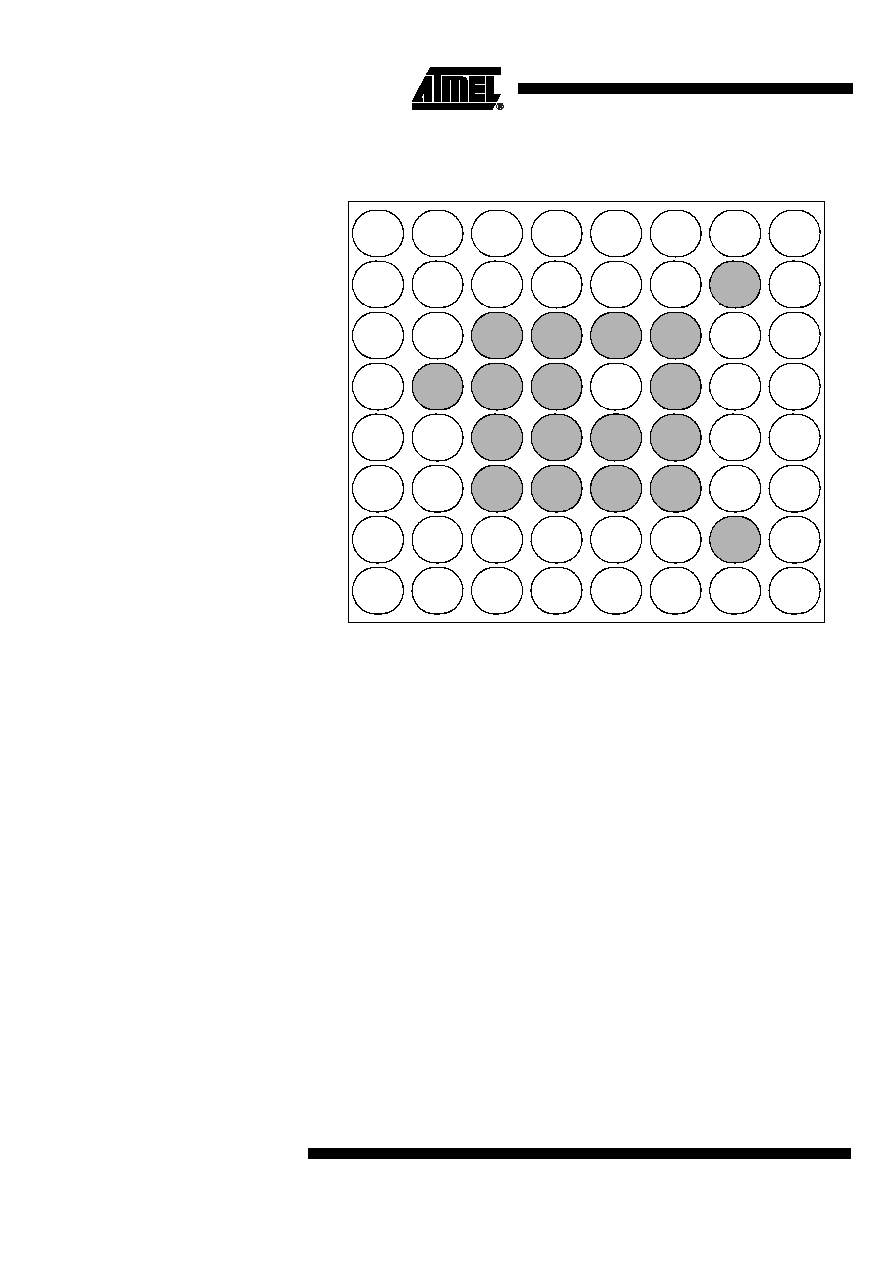
Rev. 4129L≠CAN≠08/05
1
Features
∑
80C51 Core Architecture
∑
256 Bytes of On-chip RAM
∑
1K Bytes of On-chip XRAM
∑
32K Bytes of On-chip Flash Memory
≠ Data Retention: 10 Years at 85∞C
Erase/Write Cycle: 100K
∑
Boot Code Section with Independent Lock Bits
∑
2K Bytes of On-chip Flash for Bootloader
∑
In-System Programming by On-Chip Boot Program (CAN, UART) and IAP Capability
∑
2K Bytes of On-chip EEPROM
Erase/Write Cycle: 100K
∑
14-sources 4-level Interrupts
∑
Three 16-bit Timers/Counters
∑
Full Duplex UART Compatible 80C51
∑
Maximum Crystal Frequency 40 MHz, in X2 Mode, 20 MHz (CPU Core, 20 MHz)
∑
Five Ports: 32 + 2 Digital I/O Lines
∑
Five-channel 16-bit PCA with:
≠ PWM (8-bit)
≠ High-speed Output
≠ Timer and Edge Capture
∑
Double Data Pointer
∑
21-bit Watchdog Timer (7 Programmable Bits)
∑
A 10-bit Resolution Analog to Digital Converter (ADC) with 8 Multiplexed Inputs
∑
Full CAN Controller:
≠ Fully Compliant with CAN Rev2.0A and 2.0B
≠ Optimized Structure for Communication Management (Via SFR)
≠ 15 Independent Message Objects:
Each Message Object Programmable on Transmission or Reception
Individual Tag and Mask Filters up to 29-bit Identifier/Channel
8-byte Cyclic Data Register (FIFO)/Message Object
16-bit Status and Control Register/Message Object
16-bit Time-Stamping Register/Message Object
CAN Specification 2.0 Part A or 2.0 Part B Programmable for Each Message
Object
Access to Message Object Control and Data Registers Via SFR
Programmable Reception Buffer Length Up To 15 Message Objects
Priority Management of Reception of Hits on Several Message Objects at the
Same Time (Basic CAN Feature)
Priority Management for Transmission
Message Object Overrun Interrupt
≠ Supports:
Time Triggered Communication
Autobaud and Listening Mode
Programmable Automatic Reply Mode
≠ 1-Mbit/s Maximum Transfer Rate at 8 MHz
(1)
Crystal Frequency in X2 Mode
≠ Readable Error Counters
≠ Programmable Link to On-chip Timer for Time Stamping and Network
Synchronization
≠ Independent Baud Rate Prescaler
≠ Data, Remote, Error and Overload Frame Handling
∑
On-chip Emulation Logic (Enhanced Hook System)
∑
Power Saving Modes:
≠ Idle Mode
≠ Power-down Mode
1.
At BRP = 1 sampling point will be fixed.
Enhanced 8-bit
Microcontroller
with CAN
Controller and
Flash Memory
T89C51CC01
AT89C51CC01

2
A/T89C51CC01
4129L≠CAN≠08/05
∑
Power Supply: 3V to 5.5V
∑
Temperature Range: Industrial (-40
∞
to +85
∞
C)
∑
Packages: VQFP44, PLCC44, CA-BGA64
Description
The T89C51CC01 is the first member of the CANary
TM
family of 8-bit microcontrollers
dedicated to CAN network applications.
In X2 mode a maximum external clock rate of 20 MHz reaches a 300 ns cycle time.
Besides the full CAN controller T89C51CC01 provides 32K Bytes of Flash memory
including In-System-Programming (ISP), 2K Bytes Boot Flash Memory, 2K Bytes
EEPROM and 1.2-Kbyte RAM.
Special attention is paid to the reduction of the electro-magnetic emission of
T89C51CC01.
Block Diagram
Notes:
1. 8 analog Inputs/8 Digital I/O
2. 2-Bit I/O Port
Timer 0
INT
RAM
256x8
T0
T1
Rx
D
Tx
D
WR
RD
EA
PSEN
ALE
XTAL2
XTAL1
UART
CPU
Timer 1
INT
1
Ctrl
INT
0
C51
CORE
Port 0
P0
Port 1 Port 2 Port 3
Parallel I/O Ports and Ext. Bus
P1
(1
)
P2
P3
XRAM
1kx8
IB-bus
PCA
RES
E
T
Watch
Dog
PCA
ECI
Vs
s
Vc
c
Timer 2
T2
E
X
T2
Port 4
P4
(2
)
10 bit
ADC
Flash
32kx
8
Boot
loader
2kx8
EE
PROM
2kx8
CAN
CONTROLLER
Tx
D
C
Rx
DC
V
AREF
VAV
C
C
VAG
N
D

3
A/T89C51CC01
4129L≠CAN≠08/05
Pin Configuration
PLCC44
P1
.
3
/A
N
3
/C
E
X
0
P1
.
2
/A
N
2
/E
C
I
P1
.
1
/A
N
1
/T
2
E
X
P1.
0
/A
N
0/
T2
VA
R
E
F
VA
G
N
D
RE
S
E
T
VS
S
VC
C
XT
A
L
1
XT
A
L
2
P3.
7
/R
D
P4.
0
/ T
x
D
C
P4.
1
/R
xD
C
P2.
7
/A
15
P2.
6
/A
14
P2.
5
/A
13
P2.
4
/A
12
P2.
3
/A
11
P2.
2
/A
10
P2.
1
/A
9
P3
.6/
W
R
39
38
37
36
35
34
33
32
29
30
31
7
8
9
10
11
12
13
14
17
16
15
18
19
20
21
22
23
24
25
26
27
28
6
5
4
3
2
44
43
42
41
40
ALE
PSEN
P0.7/AD7
P0.6/AD6
P0.5/AD5
P0.2/AD2
P0.3/AD3
P0.4/AD4
P0.1/AD1
P0.0/AD0
P2.0/A8
P1.4/AN4/CEX1
P1.5/AN5/CEX2
P1.6/AN6/CEX3
P1.7/AN7/CEX4
EA
P3.0/RxD
P3.1/TxD
P3.2/INT0
P3.3/INT1
P3.4/T0
P3.5/T1
1
43 42 41 40 39
44
38 37 36 35 34
12 13
17
16
15
14
20
19
18
21 22
33
32
31
30
29
28
27
26
25
24
23
VQFP44
1
2
3
4
5
6
7
8
9
10
11
P1.4/AN4/CEX1
P1.5/AN5/CEX2
P1.6/AN6/CEX3
P1.7/AN7/CEX4
EA
P3.0/RxD
P3.1/TxD
P3.2/INT0
P3.3/INT1
P3.4/T0
P3.5/T1
ALE
PSEN
P0.7/AD7
P0.6/AD6
P0.5/AD5
P0.2 /AD2
P0.3 /AD3
P0.4 /AD4
P0.1 /AD1
P0.0 /AD0
P2.0/A8
P
1
.
3
/AN3/CE
X
0
P
1
.
2
/AN2/E
CI
P
1
.
1
/AN1/T
2E
X
P
1
.
0
/AN 0/
T2
V
ARE
F
VA
GN
D
RE
S
E
T
VS
S
VC
C
XT
A
L
1
XT
A
L
2
P3.
7
/R
D
P
4
.0
/T
x
D
C
P4.
1
/R
xD
C
P2.
7
/A
1
5
P2.
6
/A
1
4
P2.
5
/A
1
3
P2.
4
/A
1
2
P2.
3
/A
1
1
P2.
2
/A
1
0
P2.
1
/A
9
P
3
.6
/W
R

5
A/T89C51CC01
4129L≠CAN≠08/05
Table 1. Pin Description
Pin Name
Type
Description
VSS
GND
Circuit ground
VCC
Supply Voltage
VAREF
Reference Voltage for ADC (input)
VAGND
Reference Ground for ADC (internally connected to VSS)
P0.0:7
I/O
Port 0:
Is an 8-bit open drain bi-directional I/O port. Port 0 pins that have 1's written to them float, and in this state can be used as
high-impedance inputs. Port 0 is also the multiplexed low-order address and data bus during accesses to external Program
and Data Memory. In this application it uses strong internal pull-ups when emitting 1's.
Port 0 also outputs the code Bytes during program validation. External pull-ups are required during program verification.
P1.0:7
I/O
Port 1:
Is an 8-bit bi-directional I/O port with internal pull-ups. Port 1 pins can be used for digital input/output or as analog inputs for
the Analog Digital Converter (ADC). Port 1 pins that have 1's written to them are pulled high by the internal pull-up transistors
and can be used as inputs in this state. As inputs, Port 1 pins that are being pulled low externally will be the source of current
(I
IL
, see section "Electrical Characteristic") because of the internal pull-ups. Port 1 pins are assigned to be used as analog
inputs via the ADCCF register (in this case the internal pull-ups are disconnected).
As a secondary digital function, port 1 contains the Timer 2 external trigger and clock input; the PCA external clock input and
the PCA module I/O.
P1.0/AN0/T2
Analog input channel 0,
External clock input for Timer/counter2.
P1.1/AN1/T2EX
Analog input channel 1,
Trigger input for Timer/counter2.
P1.2/AN2/ECI
Analog input channel 2,
PCA external clock input.
P1.3/AN3/CEX0
Analog input channel 3,
PCA module 0 Entry of input/PWM output.
P1.4/AN4/CEX1
Analog input channel 4,
PCA module 1 Entry of input/PWM output.
P1.5/AN5/CEX2
Analog input channel 5,
PCA module 2 Entry of input/PWM output.
P1.6/AN6/CEX3
Analog input channel 6,
PCA module 3 Entry of input/PWM output.
P1.7/AN7/CEX4
Analog input channel 7,
PCA module 4 Entry ot input/PWM output.
Port 1 receives the low-order address byte during EPROM programming and program verification.
It can drive CMOS inputs without external pull-ups.
P2.0:7
I/O
Port 2:
Is an 8-bit bi-directional I/O port with internal pull-ups. Port 2 pins that have 1's written to them are pulled high by the internal
pull-ups and can be used as inputs in this state. As inputs, Port 2 pins that are being pulled low externally will be a source of
current (I
IL
, see section "Electrical Characteristic") because of the internal pull-ups. Port 2 emits the high-order address byte
during accesses to the external Program Memory and during accesses to external Data Memory that uses 16-bit addresses
(MOVX @DPTR). In this application, it uses strong internal pull-ups when emitting 1's. During accesses to external Data
Memory that use 8 bit addresses (MOVX @Ri), Port 2 transmits the contents of the P2 special function register.
It also receives high-order addresses and control signals during program validation.
It can drive CMOS inputs without external pull-ups.




